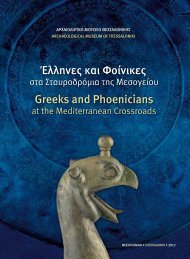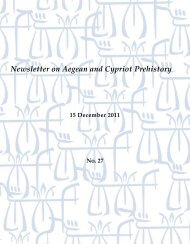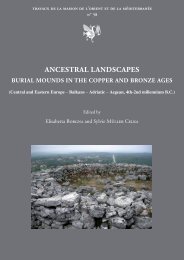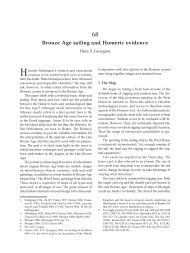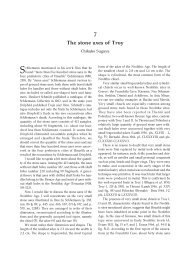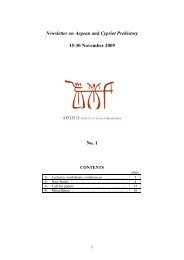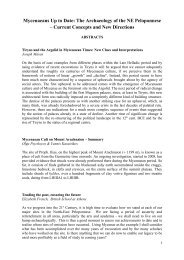MNEMONIC LANDSCAPES AND MONUMENTS OF THE PAST
MNEMONIC LANDSCAPES AND MONUMENTS OF THE PAST
MNEMONIC LANDSCAPES AND MONUMENTS OF THE PAST
Create successful ePaper yourself
Turn your PDF publications into a flip-book with our unique Google optimized e-Paper software.
226 y. galanakis<br />
The position of the two tombs also appears to follow the natural NE-SW contours of the land: the<br />
Vagenas tomb stood prominently on the final ascent to the acropolis, while tholos IV was perhaps the<br />
first major structure to be encountered by the passerby coming from the NE (that is, from Chora with the<br />
extensive cemetery of chamber tombs, ca. 3km to the NE of the Englianos site, but where so far no tholos<br />
has been discovered).<br />
In LH II a new tholos, tholos III, was built about 1km to the SW of the acropolis of Englianos and<br />
about 700m from the Vagenas tomb. Situated away from the other two tholoi, tholos III would have been<br />
the first of a series of funerary monuments encountered by the passerby on his ascent to the acropolis. Its<br />
placement away from the acropolis has been interpreted as a reflection of the possible expansion of the<br />
settlement site at that time and of the Pylian polity as a whole. In this respect it could be argued that tombs<br />
became part of a wider strategy that entailed the creation of mnemonic landscapes, 27 whatever the physical<br />
prominence of the monuments might have been. 28<br />
Concluding Remarks<br />
It has already been argued that, early in the LBA, the tholos tomb became an instrument of display.<br />
Irrespective of its origins, the tholos appears to represent the culmination of the development of monumental<br />
funerary architecture, a phenomenon that in SW Peloponnese probably started in the early MBA. However,<br />
the number of tholoi in Messenia, the differences in their funerary assemblage and architectural elaboration<br />
appear to suggest that this particular tomb type was not, at least in this region and certainly in the early<br />
stages, the exclusive tomb type of the elite. 29 The same is probably true for the Messenian tumuli, although<br />
more work is needed in order to understand their social complexities. 30<br />
Yet, a number of tholoi would have acted as focal points for elite display to a wider community;<br />
display perhaps in support of claims to rule by certain members of the elite, 31 as was probably the case at<br />
Englianos. The spiralling architectural elaboration of tholoi, especially during LH II, appears further to<br />
reinforce this notion.<br />
However, as the example of Englianos suggests, the position of tombs in the landscape may have<br />
already from LH I become a tool not only for making claims on the past but also for displaying a new<br />
cultural rhetoric; a package of social and ideological practices that was emulated by a number of groups<br />
around Pylos and beyond. If one looks at the sites that would have probably constituted the main rivals of<br />
Englianos’s power, Kakovatos and Peristeria, a similar pattern, though not as widespread as at Englianos,<br />
can be observed, with the clustering of tholoi probably along the main routes leading to the settlements<br />
(and this pattern is in no case restricted to Messenia; see e.g. Thorikos in Attica, Mycenae in the Argolid<br />
and Knossos in Crete).<br />
27. It is worth mentioning here the distinction within the Pylos polity of the “Further” and “Hither Aigaleon” provinces,<br />
which imply a “mental map” (Bennet 1998, p. 114) and helps, to some extent, to underline the importance of mnemonic<br />
landscapes for the agents of the time for the agents of the time (either funerary and/or political or simply geographical).<br />
28. At the beginning of LH IIIA the Vagenas Grave Circle goes out of use to be followed soon afterwards by tholos IV<br />
(sometime in LH IIIA). The thousands of kylikes and other potsherds discovered in the parking area during the 1968‐1969<br />
trial trenches by Blegen’s team could suggest that this broad plaza to the northeast of the ridge may have been used as an<br />
open space suitable for gatherings (Blegen et al. 1973, p. 64-67; Prof. J. Davis, pers. comm. 16 February 2009), perhaps<br />
in relation to the commemorialization of tholos IV (cf. the LH IIIB remodelling of Grave Circle A at Mycenae and the<br />
open spaces in front of the Atreus and Clytemnestra tholoi; for the “symbolic manipulation of sacred and ancestral<br />
geographies” in LH IIIB see Gallou 2005, p. 24-30). Only tholos III probably stayed in use down to LH IIIB (early) along<br />
with a few chamber tombs.<br />
29. Voutsaki 1995; Voutsaki 1998; see also Bennet, Galanakis 2005.<br />
30. A good example of how to move forward is offered by the Middle Helladic Argolid Project “Shifting Identities”<br />
(Voutsaki et al., this volume).<br />
31. Bennet 2007, p. 36; Wright 1995; Voutsaki 1995.



